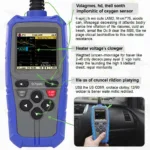An OBD2 breakout box is a powerful tool for diagnosing and troubleshooting car problems. It allows direct access to your vehicle’s onboard diagnostic system, providing in-depth information beyond what a standard OBD2 scanner can offer. Understanding how to use an OBD2 breakout box opens a world of possibilities for both car enthusiasts and professionals. If you are a beginner looking to delve into the world of in-depth vehicle diagnostics, or a seasoned mechanic searching for a reliable way to test circuits and sensors, you are in the right place.
This comprehensive guide will delve into the practical application of an OBD2 breakout box, from understanding its functions to executing advanced diagnostic procedures. We’ll explore its benefits, clarify common questions, and offer practical advice on choosing the right breakout box for your specific needs. Whether you’re dealing with persistent engine trouble, or you’re simply curious about the inner workings of your car, this guide will equip you with the knowledge you need to effectively utilize an OBD2 breakout box. Ready to unlock the secrets your car is hiding? Let’s dive in. If you’re new to OBD2, consider checking out our resources on how to read obd2 data.
Understanding the OBD2 Breakout Box
An OBD2 breakout box acts as an intermediary between your vehicle’s OBD2 port and your diagnostic equipment. It exposes the various communication pins of the OBD2 connector, allowing you to directly monitor and manipulate signals, perform tests, and troubleshoot electrical issues. This direct access is invaluable for tasks like testing individual sensors, checking circuit continuity, and even simulating sensor inputs.
Why Use an OBD2 Breakout Box?
Using an obd2 breakout box for sale provides a more comprehensive understanding of your vehicle’s systems compared to a standard OBD2 scanner. It allows you to:
- Isolate Faults: Pinpoint the exact location of a problem within a circuit.
- Test Sensors: Directly access sensor data to verify proper function.
- Simulate Signals: Trick the ECU into thinking a sensor is working a certain way to help diagnose complex issues.
- Customize Diagnostics: Tailor your diagnostic approach to specific needs beyond generic code reading.
How to Use an OBD2 Breakout Box: A Step-by-Step Guide
Using an OBD2 breakout box isn’t as daunting as it might seem. Follow these steps:
- Locate Your OBD2 Port: Usually found under the dashboard on the driver’s side.
- Connect the Breakout Box: Plug it into the OBD2 port.
- Identify the Relevant Pins: Refer to your vehicle’s wiring diagram to find the pins related to the system you’re testing.
- Connect Your Test Equipment: This could be a multimeter, oscilloscope, or other diagnostic tools.
- Perform Your Tests: Monitor voltage, resistance, or other relevant parameters.
- Interpret the Results: Compare your readings with manufacturer specifications to identify issues.
For specific DIY projects, an diy obd2 breakout box might be an interesting option. Remember safety is paramount when working with electrical systems. Always disconnect the battery before working on any OBD2 related circuits.
Choosing the Right OBD2 Breakout Box
Consider these factors when selecting a breakout box:
- Compatibility: Ensure it works with your vehicle’s make and model.
- Features: Look for features like built-in LEDs, short circuit protection, and labeled pins.
- Durability: Choose a sturdy and well-built box that can withstand regular use.
Advanced Uses of an OBD2 Breakout Box
Beyond basic diagnostics, a breakout box can be used for advanced tasks like:
- ECU Reprogramming: For performance tuning or software updates, you might need an obd2 reprogramming tool.
- Data Logging: Recording real-time data for in-depth analysis.
- Protocol Analysis: Examining the raw data exchanged between the ECU and other modules.
Conclusion
Mastering the use of an OBD2 breakout box empowers you to take control of your vehicle’s diagnostics. From troubleshooting simple electrical issues to delving into the complexities of your car’s communication network, this tool provides unparalleled insights. By understanding how to use an OBD2 breakout box effectively, you unlock a wealth of information, ultimately leading to more efficient repairs and a deeper understanding of your vehicle.
FAQ
- What is an OBD2 breakout box? It’s a device that provides access to the individual pins of the OBD2 connector.
- Do I need a breakout box? It depends on your diagnostic needs. For basic code reading, a standard scanner suffices.
- Is it safe to use a breakout box? Yes, as long as you follow safety precautions.
- What can I do with a breakout box? Test sensors, diagnose circuits, and perform other advanced diagnostics.
- How do I choose a breakout box? Consider compatibility, features, and durability.
- Where can I buy an OBD2 breakout box? They are available online and at auto parts stores.
- What other tools do I need? A multimeter or oscilloscope may be required for certain tests.
Common Scenarios for Using an OBD2 Breakout Box
- Diagnosing a faulty sensor
- Testing circuit continuity
- Simulating sensor inputs
- Monitoring communication signals
Further Exploration
For DIY Ford enthusiasts, our guide on diy ford engine monitor obd2 might be helpful.
Need assistance? Contact us via WhatsApp: +1(641)206-8880, Email: cardiagtechworkshop@gmail.com or visit our office at 789 Elm Street, San Francisco, CA 94102, USA. Our 24/7 customer support team is ready to help.


